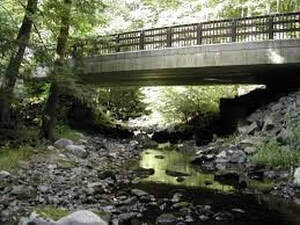CONSERVATION CORNER
A weekly blog for all things conservation
 By: Tori Bristol, Dirt Gravel & Low Volume Roads Specialist Stream crossing culverts and streams have been one of the major hot topics over the past decade. Here in Bradford County there are more than 1,000 road-stream intersections, or stream crossings, with many of those crossings being severely undersized. We depend on these crossings to safely pass roadways over streams or even rivers. We also depend on healthy waterways for clean water, recreation and other benefits. We are currently learning more and more about the relationships between stream crossing designs and the effect they have on the natural system. Undersized structures create a variety of environmental and maintenance problems such as gravel deposition, excessive erosion, flooding, and creating a barrier to the movement of fish and other aquatic organisms. Many, if not all, the municipalities in Bradford County have experienced the constant maintenance nightmares associated with undersized stream crossing culverts, like gravel bars and clogged pipes from debris. The good news, crossings can be designed to avoid or minimize these problems. The bad news, properly designed structures have a higher initial cost to install but with maintenance costs reduced the long-term overall cost will be lower.
Stream crossings that are sized to carry high flows and are designed to mimic the natural stream channel provide a number of benefits. Adequately sized stream crossings are more likely to allow water to safely pass during high flows and are less likely to damage the roadway or stream banks from storms. In extreme cases, like when the culverts fail, roads can be closed for days or months. While crossing design not only aids with flood damage, it will also minimize the downstream and upstream effects from the culvert. And for the trout fishermen or women out there, as “barrier” crossings are replaced with upgraded structures, fish can access food, cool water and spawning sites which creates new fishing opportunities. Unfortunately many of our stream culverts are too small for the size channel they are trying to pass, this is not an opinion but a fact! With the assistance of trained seasonal technicians, the Conservation District has been working toward assessing every stream culvert in Bradford County. From these assessments, it has been noted that 90% of the county’s culverts are undersized. When most of these culverts were installed there were no fancy aluminum arch pipes being made, it was find something that is relatively round, put it in the stream channel and cover it up…like railroad cars or old boilers. Properly designed stream crossings may seem a bit “overkill”, with many of the replaced structures being at least 2-3 times the size of the original. When replacing stream culverts the new structure should allow for stream continuity. This is the concept that the stream going through the crossing should look and function just as the stream does upstream and downstream from the crossing. Sounds like a novel idea, right? I mean, why take a 20-foot wide channel and squeeze it through a 6-foot round pipe? Over the past few years we have experienced more frequent and more severe rainstorms. The frequency of these storms and the amount of precipitation falling within these storms has increased over the past few decades. Due to intense storms becoming more and more frequent, properly sized and designed stream crossings are becoming even more important. With more intense localized storms, higher flows in streams and rivers will come more often and be more extreme. Our public road infrastructure will need to be able to handle these flows to minimize flooding, water quality impacts and costly repairs. Here at the conservation district we currently assist municipalities with stream crossing designs and associated permits. Over the past year, 10 stream culverts have been replaced with properly sized and designed structures that will minimize the economic and environmental impacts to Bradford County’s waterways and roadways. Upgrading road-stream crossings is by no means the only solution to the countless challenges that we will encounter due to more frequent storms, higher temperatures and other environmental changes. It is, however, a step in the right direction that provides multiple benefits. For more specific stream crossing details visit our website at www.bccdpa.com/streamcrossing The Bradford County Conservation District is committed to helping people manage resources wisely. You can visit the Bradford County Conservation District at 200 Lake Rd in Wysox across from the Wysox Fire Hall. Contact us at (570) 485-3144 or visit our web page at www.bccdpa.com.
0 Comments
Leave a Reply. |
AuthorsVarious staff at the Bradford County Conservation District Archives
July 2024
Categories
All
|
|
Bradford County Conservation District
Stoll Natural Resource Center 200 Lake Road, Suite E | Towanda PA 18848 Phone: (570)-485-3144 |
